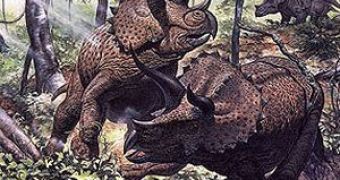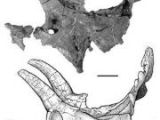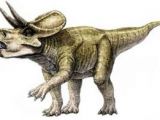One of the most evolved herbivorous dinosaurs was the ceratopsid.
Even if you are or not a dinosaur fan, these are very familiar figures to you, with their rhino like appearance, some forms possessing three large facial horns (one on the nose, and two over the eyebrows) and a large bony frill and beaked snout. Till now, these dinosaurs were found exclusively in North America.
Experts say that a new ceratopsid species with yard-long horns over its eyebrows suggests an evolutionary link between later dinosaurs with even larger horns and the previous small-horned dinosaurs. This dinosaur's horns, as thick as a human arm, were very similar to those of Triceratops, a 10 million years older species and the most known of the horned dinosaurs.
But unlike Triceratops, which was typical in his family, this dinosaur belonged to an ancestral subfamily, that of the Triceratops, which usually had bony nubbins a few inches long above their eyes. The fossil was discovered six years ago by Michael Ryan, curator of vertebrate paleontology for the Cleveland Museum of Natural History, in southern Alberta, Canada, while a graduate student for the University of Calgary. "Unquestionably, it's an important find. It was sort of the grandfather or great-uncle of the really diverse horned dinosaurs that came after it", said Peter Dodson, a University of Pennsylvania paleontologist.
The new species was baptized Albertaceratops nesmoi, after the region and Cecil Nesmo, a rancher near Manyberries, Alberta, who has participated in the diggings. This dinosaur was about 6 m (20 feet) long, about one tonne and lived 78 million years ago.
Only Zuniceratops, which lived 12 million years before Albertaceratops, was older amongst the horned dinosaurs of North America, but Zuniceratops already had large horns, even if it did not belong to the evolved group of Triceratops. "The newly discovered species makes a better intermediate link between later forms with large horns and previous small-horned relatives," said State of Utah paleontologist Jim Kirkland, who with Douglas Wolfe discovered Zuniceratops in New Mexico in 1998.
He foresaw this intermediate link.
"Lo and behold, evolutionary theory actually works," he said.

 14 DAY TRIAL //
14 DAY TRIAL // 

